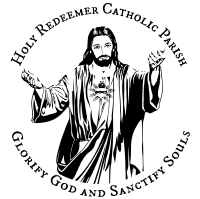What Happens When a Pope Dies?
February 23, 2025
Jesus Christ: Yesterday, Today, and Forever ~
Let’s keep Pope Francis in our prayers. As of this writing (Wednesday, February 19) Pope Francis has been in the hospital for six days and is getting better. For an 88-year-old man with double pneumonia, one lung and obesity, he’s overcoming a big set of variables, but he seems to be on the mend. This has made me reflect on the importance of the Papacy regardless of who holds Saint Peter’s Keys. I find myself feeling both sad at the passing of someone that hundreds of millions of people and I have come to know so well, mixed with trepidation at the thought of the Church being “leaderless” if only for a month or so. This in turns reminds me of how much all of us rely on the principle of authority for any institution to survive: family, the Church, civic government, business, schools, military, etc. Pope Francis’ current condition raises the question for many of us: what happens when a pope dies?
The office of the papacy is essential for the Church’s survival, that’s why Jesus Christ instituted it with our first pope, Saint Peter (Mt. 16). Whatever worrying someone may do about Pope Francis or the election of his successor, is not going to help anything but can play into the Enemy’s hands. Our prayers and penance at the death of anyone is very important for their soul, even if they are a pope. Prayers and expiation are very important to help get a good candidate elected pope.
Here’s a brief synopsis, taken from an on-line Forbes article, of what happens when a pope passes away and his successor is elected. Enjoy.
May Almighty God Bless You,
May Almighty God Bless You,
Father Thomas Nathe
Key Facts
When the head of the Roman Catholic Church dies, the “interregnum” period, or the time between a pope’s death and the election of a new leader, begins.
The pope’s death is first verified by the camerlengo—the Vatican’s overseer of property and revenues—who ceremonially calls out the pope’s baptismal name three times, and upon receiving no response, pronounces the pope dead and informs Vatican staff and the public.
The camerlengo locks the papal apartment, a historic practice because looting of the pope’s apartment was once common, and arranges for the breaking of the pope’s ring and seal to symbolize the end of his rule.
The pope’s burial must take place between four and six days after his death, according to the Universi Dominici Gregis constitution that governs the papal transition, and the Church observes nine days of mourning.
Between 15 and 20 days after the pope’s death, cardinals under 80 years of age arrive at the Vatican to begin the papal conclave, a secretive election process held to determine a successor.
Cardinals lock themselves in the Sistine Chapel, disconnected from news media and telephones to block any outside influence, and undertake multiple rounds of voting until a candidate receives a two thirds majority.
After votes are conducted, the ballots are burned: for every vote that fails, the cardinals release black smoke from the Sistine Chapel, and white smoke means that a new pope has been elected.
Once a pope is elected, the dean of the cardinals asks him if he accepts his election, if he accepts then he is instructed to choose a name.
The senior cardinal deacon introduces the pope on a balcony overlooking St. Peter’s Square in Vatican City and declares, “Habemus Papam” (“We have a pope,” in Latin), and the new pope blesses the crowd.
Key Background
Early papal elections lacked a formal structure and varied throughout history, with some popes appointed by their predecessors and some appointed by political rulers. Pope Nicholas II laid the foundation for modern papal elections in 1059, decreeing that cardinal bishops will nominate a pope’s successor and cardinal priests will vote. The papal conclave was created by Pope Gregory X in 1274 after his own election took three years, the longest papal election in the Catholic Church’s history. Under Gregory’s modifications to the papal election process, cardinals would not be allowed to leave unless a new pope has been selected. Pope Paul VI ruled in 1970 that cardinals over 80 could no longer participate in the papal conclave. The current set of rules governing papal elections was published by Pope John Paul II in 1996, with some modifications made by Benedict XVI, who reversed John Paul’s ruling that a simple majority could be accepted instead of a two thirds majority if 30 consecutive ballots fail.
Resignation of Pope Benedict XVI
A pope typically dies while in office—but the most recent papal transition occurred when Benedict XVI voluntarily stepped down in 2013, the first Church leader to do so in nearly 600 years. Then 85 years old, Benedict resigned because of declining health and his old age, officially leaving office on February 28, 2013. Benedict amended a church law allowing the papal conclave to be held sooner than 15 days because a funeral did not have to be held in the meantime. The conclave began on March 12, 2013, and Pope Francis was elected after five ballots. Francis served as pope for nearly ten years before Benedict died on December 31, 2022.
Surprising Fact
Openly campaigning—or even discussing—a pope’s successor while he is still alive is strictly forbidden for cardinals. Though cardinals do discuss candidates privately before the conclave, public campaigning is frowned upon. Instead, some cardinals with ambitions of becoming pope will covertly campaign, often by traveling to visit colleagues or delivering lectures.


